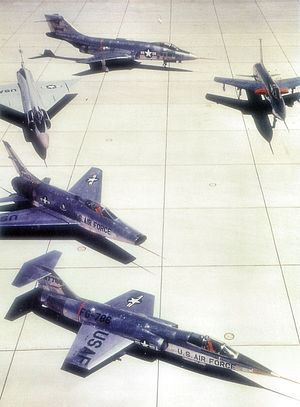The Century Series is in the news again. As reported at Defense News and Aviation Week, the Air Force is considering a new way of thinking about acquiring its next generation of air superiority aircraft. Instead of a single major project, the idea is now to produce a series of different aircraft, using an entirely new system of design and manufacture.
The United States is desperate to avoid what happened with the F-22 and the F-35, long-term projects that effectively ate the Department of Defense. Will Roper, assistant secretary of the Air Force for Acquisition, Technology and Logistics, discussed a new system (we might even go so far as to suggest “paradigm” for fighter acquisition.
Instead, according to Valerie Insinna, “the Air Force’s goal would be to quickly build the best fighter that industry can muster over a couple years, integrating whatever emerging technology exists. The service would… then restart another round of competition among fighter manufacturers, which would revise their fighter designs and explore newer leaps in technology.
The result would be a networked family of fighters — some more interrelated than others — developed to meet specific requirements and including best-in-breed technologies aboard a single airframe.” Two or more vendors would bid for the right to produce fighters for 2-3 year periods, after which the competition would restart.
Indeed, Roper seems most interested in developing new ways for design firms, manufacturing firms, and the Pentagon to work together, a process that will not necessarily look anything like the conventional relationship between industry and DoD.
The system would separate the relationship between design and production, allowing design firms to work up new aircraft, while specialized manufacturers (presumably using digital tools and artificial intelligence related applications) would produce small (around 72) runs of aircraft.
Among other things, this new system could overturn the strategy that aerospace firms have used for generations. Part of the political strategy of modern aerospace firms has been to leverage the link between design and production to political actors who can ensure the survival of the project.
This is why the F-35 is built across so many different countries, states, and Congressional districts. Roper seems to envision a different relationship between capital and labor, with a separation between design and production and the automation of a considerable portion of the production process.
This new approach matters for the Asia-Pacific insofar as it represents a major change in how fighter procurement would work in the region’s foremost aerospace power. The rest of the international implications are harder to work out.
The problems of the F-35, such that they are, are not specific to the United States. Every builder of fighters in the world has suffered from the kinds of issues that the YF-(50,59) Multitude (or ‘New Century Series’) is intended to resolve. It may well be that improvements in digital technology and a different set of design processes can dramatically reverse fifty years of evolution in fighter design, but there is some reason for doubt. My next column will think through the export implications of this new approach.

































